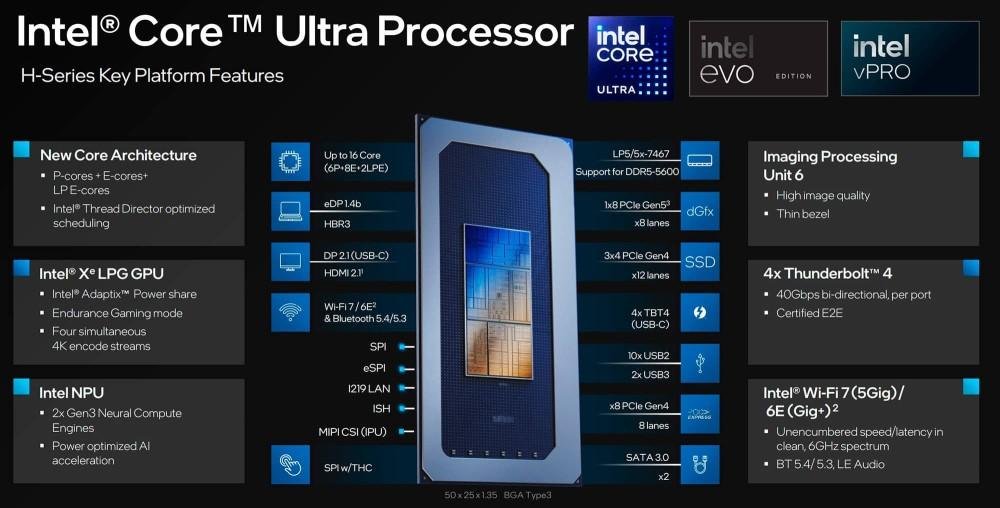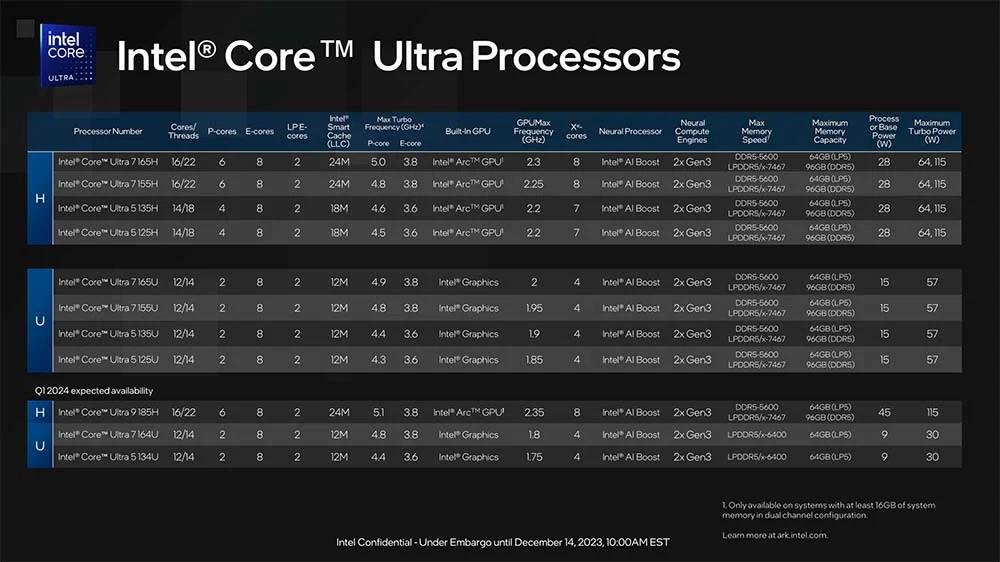This name change, as we mentioned, has to do with the E-Core and P-Core of the new Intel CPUs. Now we have two new types of cores within each chip. But it will not be the company’s only addition to its processors, other elements will arrive. That’s where these new names come in.
The rebirth of Core processors
The new name for processors comes with the Meteor Lakethe company’s 14th Generation of chips for laptops. It will not only be used in laptops, it will also reach the desktop processorswith the landing of the Arrow Lake of 15th Generation, scheduled for the end of this year.
Now we will have the names Intel Core and Core Ultra. Due to this change in name and structure, different elements disappear. Firstly, the letter “i” disappears in the name of the processor, forever (or so it seems). Thus, from now on there will no longer be the Core i9, we will have the Core 9 or the Core Ultra 9.
It also seems that in the Core Ultra we will not have “low” range processors such as the Core i3. It seems that this name remains for the “normal” Core, leaving it with the Core 3 range. In addition, the “normal” Core will not have a version of the Core i9, being exclusive to the Core Ultra.
How are Intel Core and Core Ultra different?
There are several elements that change between these two ranges of processors. The main difference is in the neural processing units either NPU. These are cores specifically to work with artificial intelligence.
Intel highlights that NPUs serve to “unlock the power of AI, create immersive graphics experiences, and enable high-performance, low-power processing.

Intel Core Ultra processors will have NPU, in addition to other elements such as the AI Boost engine. This is an engine designed to reduce the tension of artificial intelligence workflows. It allows the rest of the cores to dedicate themselves to other tasks and thus maximize the performance of the computer. Obviously, the Intel Core will not have these cores.
Another element that seems exclusive to the Core Ultra are the LPE cores. These are very low energy efficient cores for mobile chips. They seem to be very powerful cores that consume a lot of energy, although we don’t know much about them.
Only minor changes
In addition, the specification tables of these “new” processors will become much more detailed. Data such as base and Boost frequencies are given according to core type, number of cores and graphics frequency, number of NPUs and many other data.

The nomenclature also changes, noticeably. For example, the “13” in the Core i9-13900K told us the family it represented. Now we will have the name Core Ultra 7 165H, for example.
The name is simplified, indicating that the high-end with the “Ultra 7”, that it is for efficient laptops with the “H” and that it belongs to the Series 1 with the “165. At the moment it is not clear what the digits “65” in the name would mean, beyond an order of the processor within the range according to its characteristics.
These are the “big” changes
| Characteristics | Intel Core Ultra | Intel Core |
|---|---|---|
| Cores | P-Cores, E-Cores and LPE-Cores | P-Cores and E-Cores |
| NPU cores | They will have specific cores for AI | They will not have specific cores for AI |
| Frequencies | They could be older | They could be cropped |
| AI Algorithm | Integrated AI Boost | They will not have AI Boost |
| GPU | Optimal for gaming | They could come cut down to offer a limited experience |
| Connectivity | They would support WiFi 7 and USB4 | They may not support WiFi 7, staying on WiFi 6E |
| Efficiency | High efficiency in charging with AI | High efficiency in loads without AI |
We will now have two families within the same generation of processors with different ranges of chips. Getting used to all these name changes shouldn’t be a big problem. It may be a little more difficult to explain to less users the differences between processors.
Although, broadly speaking, the big difference is that the Core Ultra will have cores and other specific elements for AI and the “normal” Core will not have them. Be careful, it does not mean that the “normal” Cores are not compatible with AI, it means that they will allocate part of the resources to this task, losing some performance.
FAQ
Here’s a breakdown of some common questions you might have about Intel Core vs Core Ultra processors:
1. Core vs. Core Ultra: Which is better?
It depends! Core Ultra boasts dedicated AI cores and stronger graphics for tasks like video editing and high-end gaming. Core processors excel in everyday use and offer better battery life in some models.
2. When will laptops with Core Ultra processors arrive?
Expect them in late 2024 with the launch of Intel’s 14th Gen Meteor Lake processors. Major brands like Dell, HP, Lenovo, and ASUS will likely offer Core Ultra options.
3. Will my current software work with Core Ultra?
Yes, if it’s compatible with Windows 11 (or the latest version at the time). Core Ultra processors share the same architecture as Core processors.
4. Do I need Core Ultra for gaming?
Not necessarily. High-end Core processors handle most games well. But, Core Ultra offers superior graphics performance for demanding titles and smoother gameplay at higher resolutions.
5. How much more expensive are Core Ultra laptops?
While exact pricing isn’t confirmed, expect a slight premium compared to similar Core-equipped laptops. The enhanced performance and features of Core Ultra might justify the cost difference.
6. Is Core Ultra good for battery life?
It depends on the specific model. Some Core Ultra processors might prioritize performance over battery life. Look for models with efficient cores and Intel® Alder Lake features for better battery optimization.
7. Can I upgrade my laptop to Core Ultra?
Unfortunately, no. Processors are permanently attached to the motherboard, so upgrades aren’t possible. You’ll need a new laptop to experience Core Ultra.
8. When will Core Ultra be available for desktops?
Expect them in late 2024 with the introduction of Intel’s 15th Gen Arrow Lake processors.
9. Are there any drawbacks to Core Ultra?
Cost might be the main downside. Core Ultra laptops might be pricier. Additionally, since the technology is new, unforeseen compatibility issues with some software are a possibility.
10. Should I wait for Core Ultra before buying a laptop?
It depends on your needs and budget. If you need a powerful machine for demanding tasks and have the budget, waiting for Core Ultra could be worthwhile. However, current Core processors offer excellent performance for everyday use at a potentially lower price point.

